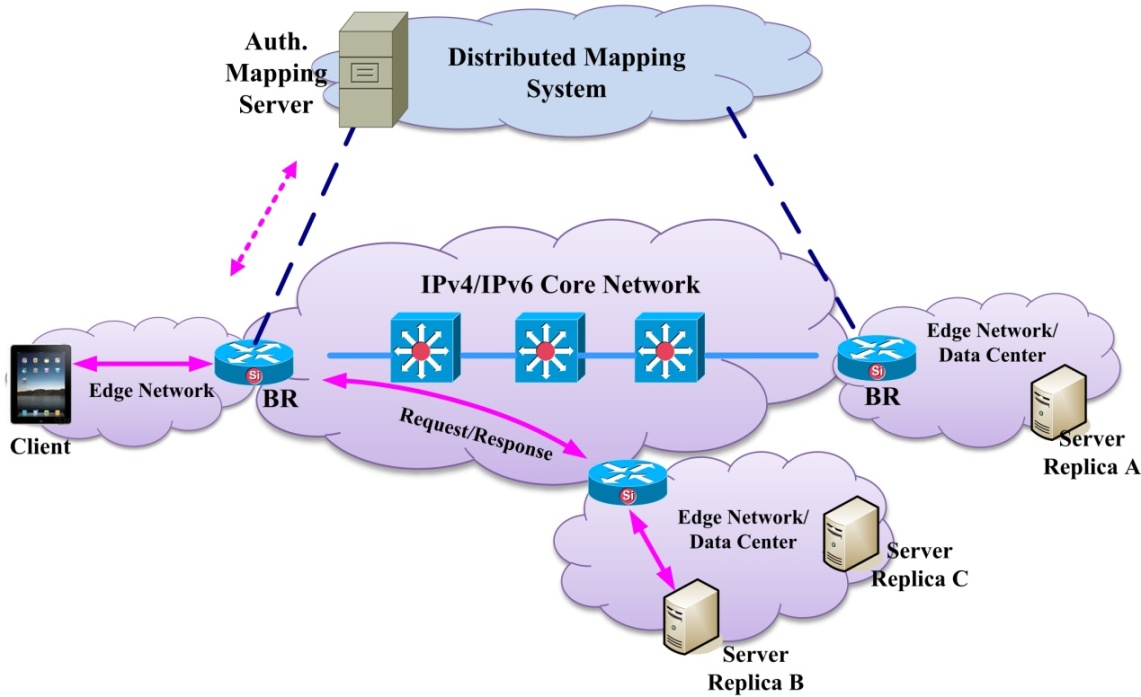Intelligent and effective anycast support becomes more pressing as the popularity of multimedia services lead to an ever-increasing demand on network bandwidth and server capacity, which outpaces the technology development and becomes the major concern of multimedia service providers. To provide high quality of service, multimedia service replication is usually adopted with the objective to increase service availability. Presently, content providers either rely on their own networks or third-party content distribution networks to achieve this purpose, mainly through lookup-by-name based anycast techniques. However, without architectural support, these solutions often cannot make optimal choices, and moreover, wasteful function over provisioning is popular among different providers.
Researchers from the Institute of Acoustics, Chinese Academy of Sciences, University of Chinese Academy of Sciences and Nanjing Normal University cooperated to have proposed an anycast network architecture (Fig. 1) that combines the merits of both the route-by-name and lookup-by-name schemes, which achieves good balance between routing scalability and forwarding efficiency, allows flexible server selection, quickly adapts to network changes and maintains flow affinity.

Fig. 1 the anycast system architecture for multimedia (Image by YUAN).
The whole network is divided into edge and core. In the edge network, routing is based on intent names, whereas in the core network, routing is based on locators as today's IP network does. The edge network obeys an Information-centric networking paradigm, in which naming convention similar to Content Centric Network is adopted. Besides, name-based routing is limited to the edge network to reduce the impact on routing scalability. Moreover, a flexible mapping system extended from LISP+ALT (Locator ID Separation Protocol and Alternative Topology) is used to map a locally routable intent name into a globally routable locator.
In the network architecture mentioned above, anycast is achieved by combining route-by-name and lookup-by-name. In the edge network, name-based routing is used so that anycast is achieved by route-by-name mechanism. Meanwhile, in the boundary routers (BRs), names are mapped to locators by an intelligent sever selection algorithm, and requests will be tunneled across the core network. As a result, in the core network, anycast is achieved by means of lookup-by-name.
Resulting from this hybrid approach, it achieves routing scalability by avoiding low forwarding efficiency and routing table inflation in the core network. The core network can be the present Internet and remain unchanged, which enables incremental deployment. As well, intelligent server selection can be achieved at the BR, which can make its decision on real-time network conditions through its routing tables and server conditions through the mapping system. In addition, flow affinity can be achieved by binding the mapping between the requesting host name and mapped server host name.
This research is supported by the National High Technology Research and Development Program (863 Program) under Grant No.2013AA013503-2, the Strategic Pilot Project of Chinese Academy of Sciences under Grant No.XDA06010302, the National Natural Science Foundation of China under Grant Nos. 61100178, 61174152, 61202419 and 61303243. This research is also partly supported by the Startup Foundation of Nanjing Normal University under Grant No. 2011119XGQ0248.
Journal References:
YUAN Sha, LIN Tao, ZHANG Guoqiang, AN Wei, LI Yang and CI Song. A Hybrid Anycast Network Architecture and Intelligent Server Selection Strategy for Multimedia Services. Transactions on Emerging Telecommunications Technologies (vol. 25, issue. 4, pp. 407–421, April 2014). DOI: 10.1002/ett.2730
Corresponding Author:
YUAN Sha
Institute of Acoustics, Chinese Academy of Sciences
Email: yuans@hpnl.ac.cn


